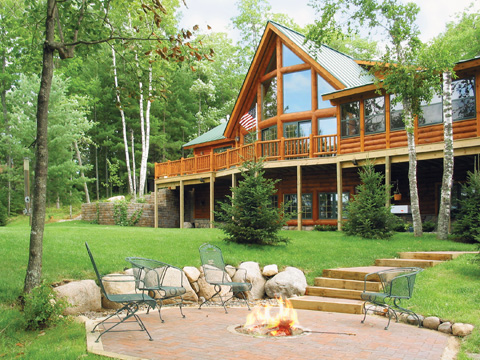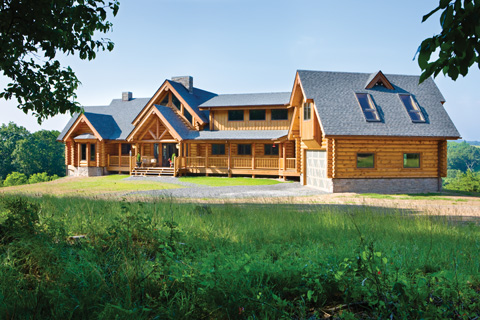In your dreams, you imagined the builder handing over the keys to your new log or timber frame home, each inch of the house completed just as you imagined it would be. But for many of us, dreams are sometimes deferred—or at least spread out over time. Whether it is due to budget restrictions or lifestyle changes, there are many reasons you might want to build your home in stages instead of completing the whole project at once.
Perhaps you intend to eventually retire to your new log or timber frame home, but in the meantime, you’ll just be using it as a vacation getaway. For that reason, it might not make sense to spend money on building a detached garage right now, but you know you’ll want one when the residence becomes your full-time home. Or maybe you can’t afford to finish the basement, but you know you’ll be working that into your budget in future years. What’s the best way to plan for that?
No matter what your reasons are, it’s crucial to talk with your log or timber frame home designer about how you hope to use your home both now and in the future. With careful planning, incorporating these future needs into your home’s design can you save you time, money, and headaches down the road.
Ron Silliboy, corporate sales manager for Ward Cedar Log Homes in Houlton, Maine, says that he always advises clients to consider future planning during the design phase. “If they don’t bring it up, we do,” says Silliboy. “Maybe this is their first home and they plan on expanding their family so they might want the ability to add space in the future.” Elizabeth (Betsy) Stead, pricing specialist at Coventry Log Homes in Woodsville, New Hampshire, agrees. “If you are a young couple starting out, you might only build out one floor with the intention to finish a second floor once kids arrive, or add an in-law apartment for aging parents,” she says.
Gauge Your Priorities
To plan ahead for your family’s needs, outline your priorities. If you will be making the home your full-time residence, it is important to complete the areas of the home that will allow you to live comfortably first: master bedroom and bath, kitchen, and perhaps the main living area.
“You want to live as comfortably as possible during the timeframe you are under construction, but in reality some household routines may be less convenient while you wait,” says Stead. “For instance, showers or washing dishes in the basement is not convenient but in a realistic timeframe you might be willing to do that while a kitchen or master bath project is underway.”
The process of outlining your priorities will also help you see where you can make changes without feeling too much pain, whether that means trading some high-end finishes in the bedrooms to get the appliances you have your heart set on, or delaying construction of outdoor living spaces so that you can afford to install radiant in-floor heating.
Avoid Unwelcome Surprises
By planning appropriately, you’ll save in the long run when you expand your home. “Change is easier and less expensive on paper than in the building process,” advises Stead. “There are also fewer surprises if the time is taken to plan ahead.”
The time to look at plumbing and electrical for the basement guestroom you plan to finish five years from now is now—not later. “You may need electrical, plumbing, and venting or even foundation work in place before you actually need it to avoid wasting time and money,” says Stead. “If you know in advance you will be expanding upstairs, go ahead and make sure you have the right roof structure to accommodate enlarging the living space.”

“Another thing we look at in the very beginning stages is the placement of the septic system,” says Silliboy. “We’ve had people who want to add on to their homes, but their septic system is in the way. It can be moved but that’s an additional expense that could have been avoided.”
There may also be special considerations when working with log and timber construction. “When you’re dealing with heavy timbers for the roof system you have to take the loads into account,” says Silliboy. “You can’t just open up any wall, you might have to put in a post or some beams.” Ward Cedar Log Homes keeps their plans on file dating all the way back to the 1930s. “It’s good to have those original plans so you can engineer accordingly.”
Your log or timber frame home designer will be able to help you understand everything that needs to be taken into consideration in your current design if you communicate your future plans right from the start. They will be able to address things you might not even think of on your own, like local building requirements. “You should plan ahead for building codes such as egress windows, insulation requirements, access for stairs and check with your local building department to confirm they will allow you to add the living space,” says Mark Elliott, vice president of Coventry Log Homes.
What Can Wait?
Areas that you can more easily plan for a later stage include garages, basements, and additional bedrooms, as well as outdoor living spaces like decks and patios. Elliott advises clients who are trying to manage their budget by building in stages to hold off on elements that can wait, rather than cutting corners on the things they really want. “Wait to build the garage for a couple of years until you have saved up some cash to put into the project,” says Elliott.
“A lot of our customers are taking advantage of dry and insulated basement construction so they can expand there later if they need more living space or an entertainment area,” says Fred Kendall, design manager at Honest Abe Log Homes in Moss, Tennessee.
With additions that will change the footprint of your home, make sure your home is situated on the building site to accommodate the new structure. “Some people will have a five-year plan,” says Silliboy. “So when you’re mapping out the site for your house, you should map out the expansion to make sure you have enough room and make sure the proper setbacks are in place.”
“With a garage we try to plan for it to be situated in an area that’s easily accessible and that we can at some point attach to the house with a breezeway,” says Silliboy. “A lot of our clients will have that breezeway or mudroom right off the kitchen, so we plan for a door and the garage in the design right off the kitchen.”
Adding upper-floor bedrooms and bathrooms will require you to plan for adequate space, ventilation, plumbing, and electrical. It is more cost-effective to include those systems in the initial construction if your budget allows or make it easy for them to be extended to the upper level. Build in enough space so that you won’t have to alter the roofline when you add bedrooms or consider adding space out from the main floor instead of up. “It is very difficult to add a second story to an existing house,” says Kendall. “It is easier to add an extension or wing to an existing structure.”
Building a log or timber frame home in stages can be done easily if you plan ahead and work hand-in-hand with your log or timber frame home designer. The more you can do to “set the stage” for future completion during the initial construction phase, the easier it will be to finish the space later.

